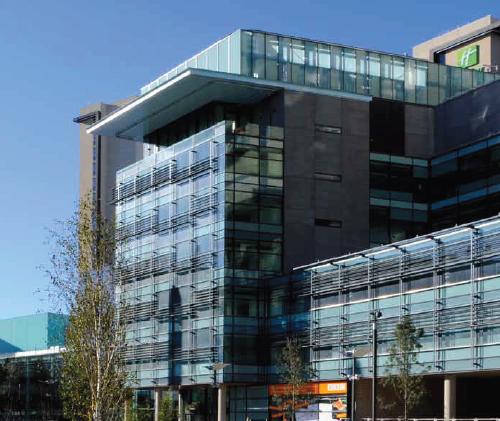
Pascal Mittermaier, head of sustainability EMEA for leading global property solutions provider Lend Lease, talks to Gay Sutton about the challenges of sustainable construction.
As far back as 1973, Dick Dusseldorp, founder of global property development and infrastructure management company Lend Lease, said: “The time is not far off when companies will have to justify their worth to society, with greater emphasis being placed on environmental and social impact than straight economics.” It was a visionary view that has shaped the company’s operational ethos for more than 50 years, placing sustainability at the heart of strategy and performance.
Headquartered in New South Wales, Australia, Lend Lease is afully integrated property solutions provider with a truly global footprint. Operating across Australia, Asia, Europe and the Americas, it provides development, investment management, project management, construction management and asset and property management services. In the UK alone, the company employs over 2,500 personnel, and lists among its many current construction projects a prestigious new mixed use development at Stratford, as well as the planned Elephant & Castle re-development project in London—one of just 17 developments worldwide that have signed up to the Clinton Climate Initiative Framework.
The argument for sustainability in construction is indisputable from the environmental perspective, and in the UK, legislation has been put in place requiring all new residential homes from 2016 onwards to be built to zero carbon standards, a target that will be extended to include offices and other non-residential buildings by 2018.
“That’s really putting pressure on builders and developers across the UK, and rightly so,” comments Lend Lease’s head of sustainability EMEA, Pascal Mittermaier. “In London, 80 per cent of all carbon emissions come from buildings. So while changing cars and black cabs or taxing air travel definitely makes a difference, what really matters in big cities is getting the buildings right.”
Lend Lease has been at the forefront of introducing sustainable construction methods such as reducing waste, minimising power consumption and switching to more environmentally friendly materials. About 10 years ago, for example, the company worked with partners, suppliers and contractors to use only FSC (Forest Stewardship Council) certified timber. “Today, everybody who wants to build a sustainable and high standard construction uses FSC timber,” Mittermaier says. “As a company we are always moving forward: at the moment we are exploring cross-laminated timber rather than cement, where we can. In addition, we want to investigate other new low-carbon alternatives for concrete, steel, rebar and bricks.”
The new events centre under construction at the Bluewater shopping centre in Kent, for example, has been designed to exemplary environmental standards and boasts, among other things, the largest green roof in the Thames area. The centre is being built using a new low-carbon concrete that incorporates recycled ash from other processes. “This is the first time we’ve used flyash concrete on such a large scale project,” Mittermaier says. “It does take a little longer to cure, but once it’s cured it’s more stable and tougher than normal concrete. From a sustainability standpoint, our analysis shows that it contains 40 per cent less carbon—with no major increase in costs.”
The company has established a process for investigating new materials and construction methods, and testing them out rigorously in practice. The knowledge and lessons learned from this experience are then entered into a database and disseminated through the company as a way of continuously evolving corporate best practice.
If a construction project is to be truly sustainable, though, Mittermaier believes it has to fulfil what he calls the ‘three criteria of the triple bottom line’: displaying obvious human, environmental and financial benefits.
The human element consists of creating well planned spaces that are attractive to people, promote health and wellbeing, fulfil a local need and provide employment within the local community. The environmental benefits include low carbon emissions across the construction project and in the subsequent running and maintenance of the buildings. This is done in a variety of ways, from reducing power consumption through the use of appropriate technology, intelligent project management such as coordinated logistics, switching off idling equipment and using generators appropriately sized to the job, reducing water consumption through processes such as water recycling and rainwater capture, and of course, recycling waste.
Lend Lease currently diverts more than 95 per cent of waste away from landfill—a practice that, with the cost of landfill currently running at approximately £100 per ton, yields significant savings. And this financial element is one that cannot be ignored. “Many companies have traditionally focused on profit and neglected the planet while traditional environmentalists have focused on the planet without worrying about how to sustainably finance it, and that’s where the difficulty lies. If sustainable construction and building management does not contribute to profitability, then it’s simply not sustainable,” Mittermaier says. “Our challenge, as an industry, is to win that equation.”
The industry also faces a second major challenge: new buildings account for one to two per cent of building stock annually. Therefore, in 25 years, up to 70 per cent of buildings will still be ‘old’. “Our challenge is that there are over 25 million homes that will have to be retrofitted or refurbished if we are to achieve the government’s target of reducing greenhouse gas emissions by 80 per cent by 2050—with many of those over 100 years old.”
The technology for achieving this is largely in place, although it is continuously being improved. Managing these retrofits, however, will require a holistic approach that can only be achieved through effective coordination and management of the various trades, and a significant change to behaviour. For example, the hassle of a lengthy retrofit is simply not worth the potential financial savings from energy efficiency. People will only accept invasive upgrades to their homes if they are short, crisp, and well-organised. So the new skills are not necessarily in the actual refurbishing of a building—they are in the coordination and integration of many trades to make sure upgrades are done quickly and seamlessly.
It is not enough to get people to switch off lights and equipment. “What is required is a very complex mix of infrastructure change and behaviour change,” Mittermaier explains. “For example, we can install smart meters to get real time information on energy or water use, but if the residents don’t know how to use them, or facilities managers don’t procure the right spares, or investment hasn’t gone into behaviour training and motivation, that won’t help achieve a more sustainable way of living and operating in the buildings.”
What is beyond doubt is that the principles of sustainable construction are advancing very quickly: they will have to if all new buildings are to conform to zero carbon standards by 2018, and Lend Lease is playing its part in that advance. “The important thing about sustainability is to have a sense of humility about it. We don’t have all the answers and solutions and the danger is that we often only solve one problem at a time, sometimes creating new, unitended consequences,” Mittermaier continues.
“Sometimes it’s literally a step-by-step process, and sometimes we achieve a big breakthrough. The ultimate measure of success is when sustainable processes become embedded in the daily operations of a company. It’s all about thinking holistically and understanding how systems interact. Sustainability is truly a fascinating topic to be working on, lots of complexity. In many areas it’s about completely rethinking how we do business and there’s never a dull moment.” www.bovislendlease.com













